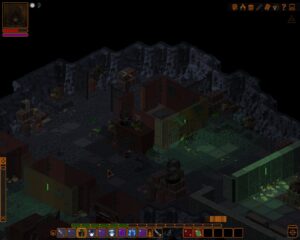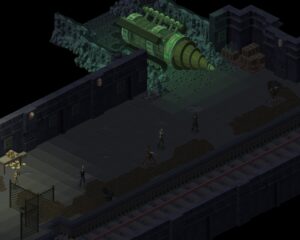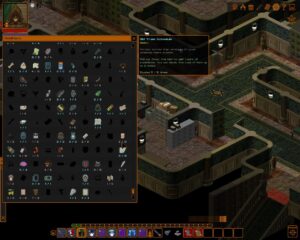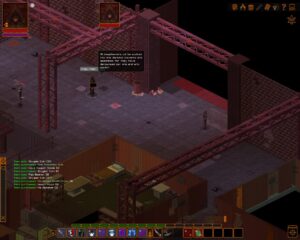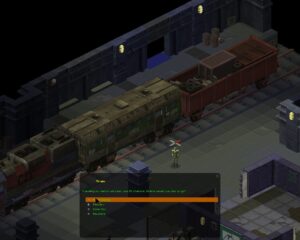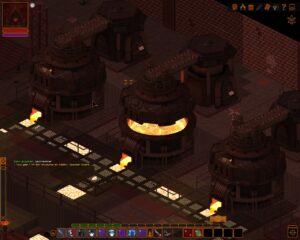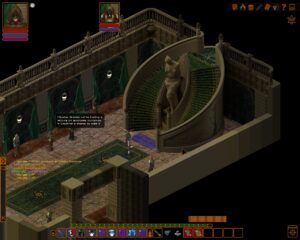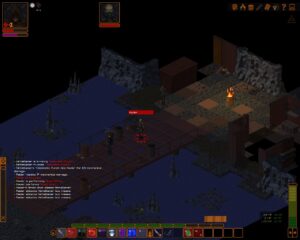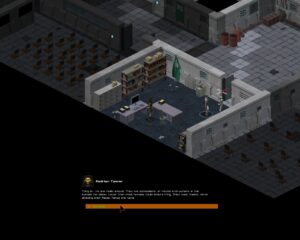UnderRail is an old-school turn-based RPG inspired by the 1990s cult classic Fallout, released in 2015 with a title that begins with ‘Under,’ and was made, for the most part, by a single person. Surprisingly, it’s not the only recent game in which the latter part of the previous sentence describes.
All jokes aside, UnderRail is a game that was clearly inspired by the famous Fallout series, specifically the first two entries. The influence from these Interplay classics can be felt in everything from UnderRail’s isometric perspective to its post-apocalyptic setting. However, it’s the most obvious when it comes to combat and character building. The former is the central part of gameplay: fights are turn-based, you control a single character, and it’s incredibly deep.
Your character can use fists, knives, crossbows, guns, explosives, nets, bear traps, caltrops, psi powers, and more I may have forgotten. You combine these with different kinds of armor, shield generators, cloaking devices and stealth–but the game forces you to play it safe, as enemies have these things at their disposal as well, along with superior numbers.
Positioning plays a major role in combat, so getting into an advantageous spot (usually somewhere where you won’t have to fight too many enemies at the same time) with the help of stealth and/or a ‘force field’ psi power can spell the difference between victory and defeat.
There are two major differences between UnderRail and Fallout’s combat: a greater focus on status effects, and a reliance on cooldowns. The former works to UnderRail’s advantage, as the diversity of positive and negative status effects adds even more depth to the combat. Of course, there’s your garden variety poison, as well as a few different immobilization effects.
However, there are also temporary stims which make you weaker after they wear off, and effects like rage, fear, being frozen/on fire, or simply getting lower defenses because a hammer to the head put you off balance. Mastering UnderRail requires knowledge of how to best cause and avoid these status effects.
Cooldowns are something I’m personally not a fan of. Sure, they do make combat more balanced, and prevent some cheesy tactics. Even still, I kinda miss hoarding healing items and explosives for that one difficult fight. In my opinion, it’d be better if instead of using cooldowns, balancing was done through cost (money for grenades/healing items, ‘mana’ for powerful psi attacks) and scarcity.
In addition to combat, UnderRail has one of the best stealth systems in the CRPG genre. Your ability to sneak past enemies is detemined by a number of factors: first, there’s obviously your skill level and bonuses from equipment. But there’s also light, sound, proximity, direction (it’s easier to spot someone in front of you than someone behind you) and even security cameras–which, if you get in their range, make patrolling enemies go to the camera’s location. It’s not as good as in a proper stealth game, but it easily beats stealth systems in both classic (e.g. Fallout, Arcanum) and modern (e.g. Skyrim) RPGs.
Character building is very similar to Fallout. You’ve got stats, which are pretty similar to S.P.E.C.I.A.L., though instead of Luck you get Will. You also have skills for different weapons, avoiding enemy attacks, stealth, lockpicking, crafting, and a few speech-related abilities. Feats are similar to Fallout’s perks in that they’re specific bonuses, special attacks, and the like. A proper character build requires a certain degree of specialization, but there are also caps related to your current level. These prevent you from putting everything into one stat and one-shotting things at level 3.
While some builds are clearly better than others, it’s still possible to play the game with a non-optimal character. My psi-stealth-melee guy would benefit from better dexterity, lockpicking, evasion, and intimidation, but he’s still doing pretty well after I learned how to actually play the game.
UnderRail features an interesting experience and leveling system. While it’s possible to play it like a standard RPG with points for killing enemies, the game is meant to be played with the ‘oddity system,’ where you’re rewarded for completing quests and finding flavor items. It’s a pretty cool idea, since it rewards exploration while discouraging grinding. It does work well, though I personally feel it would be better suited for a less combat-heavy game. Even my lightly-armored stealth character got into so many fights, I don’t think he would be too far behind in the ‘classic’ mode.
While the game does have some wonderfully complex mechanics, it has one glaring flaw: it doesn’t adequately explain most of them. There is a tutorial and some help regarding the interface, but I still needed to go to the game’s Wiki to look up a few crucial things like ‘armor penalty.’ A game as complex as UnderRail should have an in-depth manual with descriptions, numbers, and tables–kind of like old CRPGs used to have.
From a storyline perspective, UnderRail is a mixed bag. The lore of the game, for one, is fascinating. The Earth ended up with an uninhabitable surface, which forced humans to live underground. There’s a lot of cool stuff behind the scenes, like the Metro connecting independent station-states, the strange societies, a religious cult, mysterious Faceless who live in the depths, the evolution theme, and the cosmic horror lurking in the background.
Unfortunately, the events that actually transpire in the game are somewhat dull. It’s mostly faction politics, but you’re never given much reason to care about either of them. For example, there’s a conflict between the anarchist gang, “Free Drones,” and the militaristic Protectorate, which unites stations under its banners but always seems distant and abstract. You can side with both but you never see the effect of it. Protectorate seems tyrannical, but you never see their tyranny. Station’s leader says that they give them safety but for a cost – but we don’t see what the cost is.
This problem is made worse by the fact that the game lacks interesting major characters. Most of the cool ones are fairly minor, like Evelyn and Carnifex, while the recurring ones are usually walking quest dispensers. The game’s writing is just as dry as the characters. It’s not horrible, it just isn’t great either.
Another of the story-related problems is the overall quality of quests. Most of them are uninteresting, and often boil down to ‘kill those guys, get those items from here to there, talk to this guy or that guy.’ There are a few great ones which stand out from the crowd, though. My favorite has to be a romance sidequest, which quickly turns into your character having to find a way to survive an encounter with a serial killer, with no access to items or psi powers–but they’re an exception rather than the norm.
While some quests have multiple solutions, there’s rarely any sort of consequences to choosing one over the others. You can kill Rathound King for the inhabitants of Camp Hathor, or make peace between them. You can kill raiders who enslave innocent people, or do nothing about the situation. Nothing changes. At certain points in the game you can return electricity to outposts so they can be used again, or exterminate monsters that live in the mines so that miners can return, but the outposts are never used again and the miners never return.
The amount of freedom the game gives you is fairly good but it compares negatively to Fallout and Arcanum. It’s mostly in minor things but it does add up: you can’t use hammers, explosives or grenades to destroy doors, you need to unlock them (which sometimes can be done with lockpicking but sometimes requires a specific key).
You can’t blow up rocks with mines or grenades, it needs to be either TNT or a jackhammer (a restriction placed so that you won’t get to certain areas too early as those items can’t be acquired before a certain point in the game); you can’t use pick-pocketing to place armed explosives in someone’s pocket, it’s just there for stealing; there is now low intelligence dialog – a low-int character suffers skill penalties but his stupidity isn’t reflected in dialog.
The most annoying example is a quest which is set up almost like a reference to the original Fallout: you witness members of a religious cult stealing an important item and need to infiltrate their headquarters; as cultists wear robes and after witnessing the theft a few hostile ones are spawned, it would seem that you’ll be able to kill one of them, take the robes and walk into the headquarters while pretending to be a cultist (see: Children of the Cathedral in Fallout 1). Unfortunately, the cultists have absolutely no reaction (not even recognizing that you’re an impostor) to you dressing up as one of them and the only way to get inside is by doing a quest about retrieving an item from a group of hostiles.
UnderRail is structured a bit differently from most RPGs, especially those that inspired it. While the general three act structure with more restrictive beginning and endgame (generally speaking the least interesting parts of the game as early game has you fighting the same low-level monsters while the late game is a slog through tough the hordes of tough, respawning enemies) and a long, open-ended middle of the game is there, there are no real beginner areas or expert areas (aside from the aforementioned early game and late game). Instead, quests in each mid-game town go from fairly easy to very hard and you’re supposed to regularly travel between those different places. It’s not a bad choice, although it takes a bit getting used to the fact that occasionally, a questline has a difficulty spike which forces you to temporarily abandon it and do something else.
What UnderRail does perfectly is the atmosphere. The game world feels harsh, inhospitable and unwelcoming. Its world doesn’t belong to humans anymore and the further you get from civilized stations the more apparent it becomes. Everything in the game – the architecture, the enemy design, the confusing layout of underground caves, the unforgiving difficulty (the game is considerably harder than old Fallouts) – creates tension and the feeling of being in danger.
The idea of a dying, uncaring world in which nothing and no one cares if you live or die is nothing new but UnderRail approaches it differently than other games: there’s no elegant melancholy of Banner Saga or crazed but ultimately sad remnants of former glory like in Dark Souls; there’s only brutal, visceral struggle for survival as you’re being replaced with things better adapted to this strange world.
The visuals in UnderRail are decent. The sprites and the portraits are pretty good (but there’s not enough of them and your character ends up sharing one with some NPC) but not outstanding. Some of the locations have pretty cool designs – the industrial Foundry, the classical Institute, the mysterious Deep Caverns – but unfortunately, there’s too many of the samey-looking caves, tunnels and slums (usually gray-colored for more dullness) filled with similar enemies. I wanted to complain about the lack of variety but it wouldn’t be fair – there is variety in UnderRail, it’s just that cool new things are separated by dozens of gray caves filled with rathounds and bandits. I like the complexity and interconnectedness of the levels and have no problem with drawing my own maps but after so many hours (UnderRail is a very long game), they wear out their welcome.
UnderRail features a very good soundtrack consisting of appropriately atmospheric music. Most of the tracks are industrial and dark ambient and the further you get in the game, the more tense and unsettling the music becomes. My favorite piece of music has to be the one that plays when you explore Institute of Tchort with its slow, dissonant synthesizers, the high pitched, wordless (or seemingly wordless) choirs and a crescendo rhythm section.
Overall, I might have complained about UnderRail a bit but I really enjoyed it and I think it’s one of the better Fallout-like games out there, maybe the best since Arcanum. It’s not as good as Fallout or the aforementioned Arcanum but then again, not many things are. As someone who cares about story, characters and choices in RPG more than combat, I can’t help but be a bit disappointed – but I can appreciate good combat and I recognize UnderRail as a game which excels at this. For me, it’s better to approach this not as the next Fallout but as a very good Fallout-inspired dungeon crawler. If you play UnderRail with this mindset, you will be satisfied.
UnderRail was reviewed on the PC using a digital copy purchased by Niche Gamer. You can find additional information about Niche Gamer’s review/ethics policy here.
The Verdict: 7.5
The Good:
- Deep, complex combat system
- Great stealth mechanics
- Harsh, unwelcoming atmosphere
- Extremely polished for indie RPG standards
The Bad:
- Not as non-linear or focused on choice as the games it draws inspiration from
- Relative lack of memorable characters
- Early game and endgame are not that great
- No Manual

